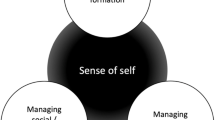Abstract
In the context of the poor rates of treatment outcome in adult presentations of anorexia nervosa (AN), the need for new or augmentative treatment interventions is increasingly apparent. Recent developments have advocated for the age-appropriate involvement of family members in the treatment of adults with AN, given the efficacy of family-based interventions in adolescent populations. This manuscript presents the case of a 35-year old male with sever and enduring AN, whose symptoms were not responsive to individual treatment although did subside upon the introduction of an augmentative course of strategic couples therapy. This case may therefore contribute to the development of novel treatment interventions in adult presentations of AN when standard treatment alone fails to bring about symptom resolution.
Similar content being viewed by others
References
Boscolo, L., Cecchin, G., Hoffman, L., & Penn, P. (1987). Milam systemic family therapy: Conversations in theory and practice. London: Basic Books.
Bulik, C. M., Baucom, D. H., & Kirby, J. S. (2012). Treating anorexia nervosa in the context of the couple. Journal of Cognitive Psychotherapy: An International Quarterly, 26, 19–33.
Bulik, C. M., Baucom, D. H., Kirby, J. S., & Pisetsky, E. (2011). Uniting couples (in the treatment of) anorexia nervosa (UCAN). International Journal of Eating Disorders, 44, 19–28.
Doyle, P., Le Grange, D., Loeb, K., Doyle, A. C., & Crosby, R. D. (2010). Early response to family-based treatment for adolescent anorexia nervosa. International Journal of Eating Disorders, 43, 659–662.
Eisler, I. (2005). The empirical and theoretical base of family therapy and multiple family day therapy for adolescent anorexia nervosa. Journal of Family Therapy, 27, 104–131.
Fairburn, C. G., & Beglin, J. S. (1994). Assessment of eating disorders: Interview or self-report questionnaire? International Journal of Eating Disorders, 16, 363–370.
Hildebrandt, T., Bacaw, T., Markella, M., & Loeb, K. L. (2010). Anxiety in anorexia nervosa and its management using family-based treatment. European Eating Disorders Review, 20, e1–e16.
Le Grange, D., Lock, J., Agras, W. S., et al. (2012). Moderators and mediators of remission in family-based treatment and adolescent focused therapy for anorexia nervosa. Behaviour Research and Therapy, 50, 85–92.
Lock, J., Le Grange, D., Agras, W. S., & Dare, C. (2001). Treatment manual for anorexia nervosa: A family based approach. New York: Guilford Press.
Lock, J., Le Grange, D., Agras, W. S., et al. (2010). Randomized control trial comparing family-based treatment with adolescent-focussed individual therapy for adolescents with anorexia nervosa. Archives of General Psychiatry, 67, 1025–1032.
Madanes, C. (1981). Strategic family therapy. San Francisco, CA: Jossey-Bass.
McIntosh, V. V., Bulik, C. M., McKenzie, J. M., Luty, S. E., & Jordan, J. (2000). Interpersonal therapy for anorexia nervosa. International Journal of Eating Disorders, 27, 125–139.
Murray, S. B., Thornton, C., & Wallis, A. (2013). Selective eating in a 9-year old boy: Family therapy as a first line treatment. Clinical Child Psychology and Psychiatry, 18(2), 269–274.
Steinhausen, H. C. (2002). The outcome of anorexia nervosa in the 20th century. American Journal of Psychiatry, 159, 1284–1293.
Strober, M., & Johnson, C. (2012). The need for complex ideas in anorexia nervosa: Why biology, environment, and psyche all matter, why therapists make mistakes, and why clinical benchmarks are needed for managing weight correction. International Journal of Eating Disorders, 45, 155–178.
Wallin, U., & Kronvall, P. (2002). Anorexia nervosa in teenagers: Change in family function after family therapy, at 2-year follow-up. Nordic Journal of Psychiatry, 56, 363–369.
Wallin, U., Røijen, S., & Hansson, K. (1996). Too close or too separate: Family function in families with an anorexia nervosa patient in two Nordic countries. The Journal of Family Therapy, 18, 397–414.
Author information
Authors and Affiliations
Corresponding author
Rights and permissions
About this article
Cite this article
Murray, S.B. A Case of Strategic Couples Therapy in Adult Anorexia Nervosa: The Importance of Symptoms in Context. Contemp Fam Ther 36, 392–397 (2014). https://doi.org/10.1007/s10591-014-9301-y
Published:
Issue Date:
DOI: https://doi.org/10.1007/s10591-014-9301-y




